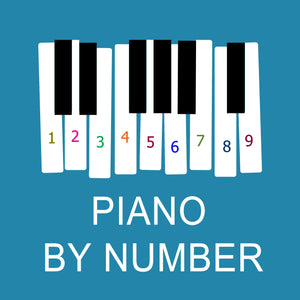Basic Piano Chords for Kids

Basic piano chords are important for children. This is because chords are the DNA of music theory, and allow kids to play a simple accompaniment.
Think of chords as three piano keys, one on top of the other. Take any white piano key and then skip a white key (up, to the right). Then play the next white key (up, to the right.) Look at the fingers in the photo above: they are playing "every other" white key.
You now have two white keys separated by an unused white key in between. That is a chord in its most simplified form for children’s use. For kids, we start with "two note chords," because that is easier for them to grasp.
Look at the drawing below. There are three books stacked up, just like the notes in a three note chord, a "triad."

Kids readily understand this, just as they understand how to create with blocks and Legos. Stack them on top of each other. Leave one out if you like. Chords, taught as an abstract, single-handed game, are an easy idea to pick up.
Teach Yourself Piano
Playing With Both Hands Is Difficult
It is when you want to have the child play chords in one hand and then a melody in the other that you run into problems. Children’s brain hemispheres are in varying states of separation and this accounts for the difficulty some younger kids have in playing with two hands. It is best to separate the two skills, playing with both hands, and chords, to prevent this confusion.
For a child who has difficulty with two hands, it is excruciating to watch. The discomfort is palpable and real. They are in mental distress and the teacher needs to find ways to dilute the suffering or they will become “allergic to left hand,” as one child put it.
But you can and should embark on an exploration of chords, one-handed if necessary. All chords are played in root position, and you should allow the child to play two-note chords (omitting one of the three members) if that is what comes easily to them.
The C chord is the center of the child’s harmonic universe. Next come F and G. Work with those three chords and the literally billions of songs that use primarily only them. No more than 6 chords are needed to play almost any song: C F G D E and A.
Just Like The Primary Colors
I often explain that the three chords C, F and G are like the primary colors, blue, yellow and red. Children readily understand that analogy.
When the child is comfortable with the “Big Three,” (C, F and G) teach the D chord, which has a black key in the middle. Once again, a two note D chord is all that most children’s hands can reach.
Once you have taught the D chord, and teaching those first four chords could take a year for it to be automatic, you are ready for minor chords.
Try Chords On Online Piano
Here are two of the most basic chords, C and F. If you have a real piano you can play each group of three keys all at once.
PIANO BY NUMBER
We've turned notes into numbers for happy beginners at the piano!

PLAY FUN PIANO GAMES!
Turn that big piano into a toy! Play fun piano games with your child today! We help take the confusion out of beginning music theory.

GET A DOWNLOAD!
International orders are welcome on ebooks! If requested we will send free pre-printed stickers worldwide! No shipping charges on downloads!

eBOOKS INCLUDE STICKERS!
eBooks include a sticker template. You can use the sticker template and/or request FREE pre-printed stickers sent via surface mail.

